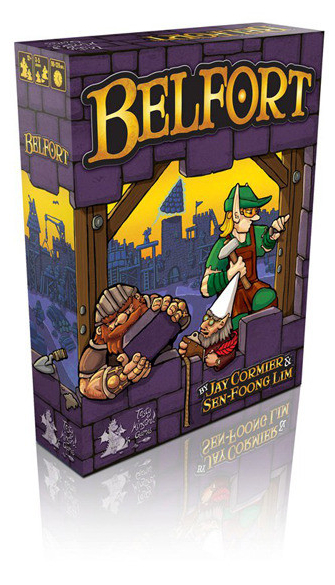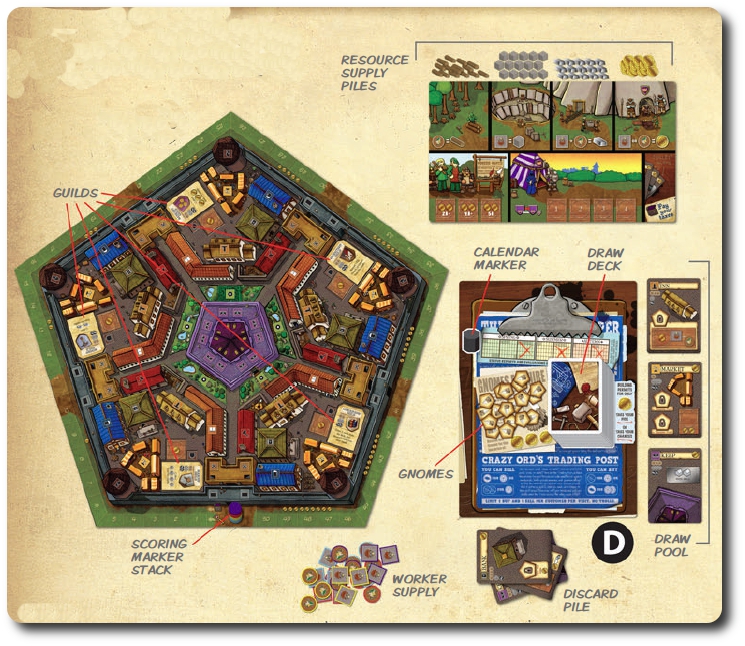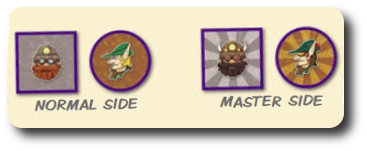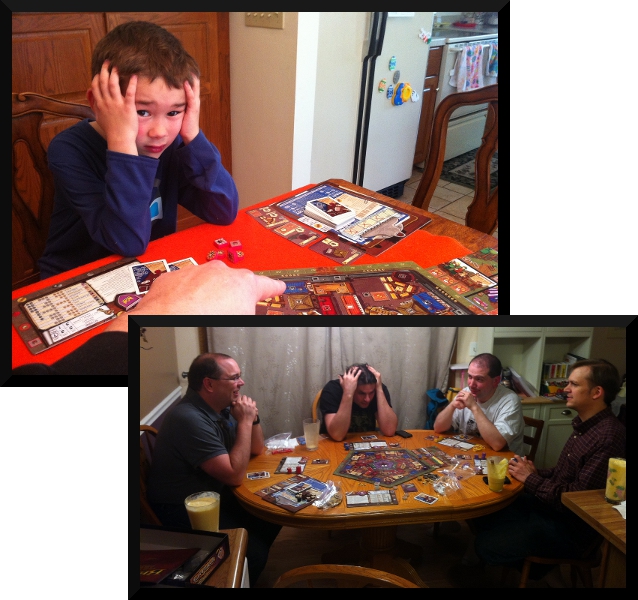
The Basics:
- For ages 13 and up
- For 2 to 5 players
- About 2 hours to complete
Geek Skills:
- Active Listening & Communication
- Counting & Math
- Logical & Critical Decision Making
- Reading
- Pattern/Color Matching
- Strategy & Tactics
- Risk vs. Reward
- Hand/Resource Management
- Auctioning, Bidding, & Trading
- Worker Placement & Area Control
Learning Curve:
- Child – Hard
- Adult – Moderate
Theme & Narrative:
- As if building a city wasn’t difficult enough, now you have to deal with the competition
Endorsements:
- Gamer Geek approved!
- Parent Geek rejected!
- Child Geek rejected!
Overview
The city planners of the illustrious new city of Belfort have made a slight clerical error. Turns out that several letters of acceptance were dispatch to Master Builders and their crews when only one was needed. That means the city is now overrun with construction Dwarves, Elves, and Gnomes, running back and forth with building materials and getting in everyone’s way. The upside is that the city is being built in record time! The downside is that you are legally (and magically) bound to fulfill your contract. Oh well, might as well make the best of it. Organize your construction crew and build the city faster than your competition. Do so and you could win the Key to the City and a well-earned vacation!
Belfort by Tasty Minstrel Games is comprised of lots and lots of bits.The game box comes with 5 game board districts that are put together to create a pentagon, 1 Calendar board, 1 Collection board, 5 Player boards, 5 turn order crests, 1 Key to the City (not used in the game), 50 Property cards, 1 Calendar marker (keeps track of the game round), 12 Guild tiles (basic, resource, and interactive types), resources (3o wood, 30 stone blocks, 20 metal bricks, and 46 gold coins), 6 multiplier chips (used to represent larger numbers of resources), workers (35 Dwarves, 35 Elves, and 22 Gnomes), 60 Property markers, and 5 Scoring markers. All the bits are of high quality and are either thick card stock, thick cardboard, or wood. The illustrations and art direction are excellent throughout, completing an outstanding presentation.
Note: Belfort is a big game that comes with an 18 page, full-color rules book. Instead of summarizing the entire contents of the book and making this review a 20 page affair, we highly encourage you to read our review and then take a look at the game’s instruction book available from the game’s official web site.
Game Set Up
Note: Belfort requires a little more pre-game set up than your average game. The worker pieces need to have stickers applied to them. The process is not difficult, but it is time intensive as the game owner is required to apply 92 stickers to small pieces. I’ll just let that sink in…
To set up the game, take and place the 5 game boards to create a pentagram ensuring the number track that surrounds the board is in sequential order. Place the Collection board next to it. Next, choose 5 Guild tiles (depending on the game difficulty, you’ll be selecting different Guilds) and place them on the Guild spaces on the game board. Place the resources in piles next to the game Collection board and within easy reach of all players.
Place the Calendar board to the side of the game board and place and deal out 3 Property cards, face-up, next to it. Place the remaining Property cards face-down on the Property card location on the Calendar board. Depending on the number of players, add the correct number of Gnomes to the Calendar board and then place the Calendar marker next to the first box for Spring.

Example of game board, Collection board, and Calendar board set up
Hand to each player 1 Player board in a color of their choice, 7 Dwarves and 7 Elves in the color that matches their Player board, 12 Property markers in the same color, and 1 scoring maker that also matches the color. The players should then select 3 Elves and 3 Dwarves as their starting workers, making certain the “normal” side of the Elves and the Dwarves are face up. The remaining workers should be set aside and kept separate from the initial 6 workers. Each player should also get 1 wood, 1 stone, 1 metal, and 5 gold resources. The players are then dealt 5 Property cards. The players look at the 5 cards, select 3 to keep, and discard the rest, putting any discarded cars at the bottom of the Property deck. Lastly, randomly hand out 1 turn order crest and place the player’s scoring markers on the game board.
If you are playing a 2-player game, the game set up is slightly different and covered in the Appendix of the rule book.
Believe it or not, you are now done setting up the game! Take a moment to go get yourself a glass of water as I am sure you are winded.
Playing the Game
The game’s turn order is fairly straight forward with 4 phases for most of the game and a 5th phase when scoring 3 times per game, for a total of 7 rounds in the game. All players play at the same time during a single round in turn order sequence. Once all the players have completed a phase, the next phase is started. The phases are as follows:
Calendar Phase
At the beginning of each phase, the Calendar marker is advanced one month. If the month is marked with an “X”, the round will have a 5th Scoring Phase.
Placement Phase
In turn order sequence, the players take turns assigning their workers to specific locations on the game board or the Collection board. This is done by placing either a Dwarf or an Elf on a “plank” which looks like a square with a circle in it. The player can only place 1 worker at a time unless they choose to end their turn which allows them to place any remaining workers to gather resources.
Collection Phase
All the players now collect their workers from the Collection board, starting with resources, the two special locations on the Collection board (the recruitment and the King’s camp), and then all players are given any income and forced to pay taxes. If a player cannot pay their taxes, they must pay in victory points. Ouch.
Action Phase
In turn order sequence (noting that the turn order itself might have shifted due to what players might have placed on the Collection board), the players now take all the actions they want to complete and can pay for. This includes building walls, building properties, building guilds, activating workers placed on action spaces on the game board, visiting the trading post (once per turn), hire a Gnome (once per turn), and finally, as a last action, buy a Property card.
Scoring Phase
Three times per game, a scoring phase will be triggered. When this happens, players will score victory points (tracked by the numbered spaces that surrounds the board). Players are awarded points for city district and worker majority.
Hire Well, Hire Often
The game uses shapes and icons brilliantly throughout to clearly communicate to the player where worker placement is possible. For “planks”, this is a square (Dwarves) and circles (Elves). Wherever a circle and square is located, a Dwarf and Elf can be placed. Likewise, Gnomes have special spots and are used to “unlock” special actions and bonuses on Property cards. There is literally a place for everything and everything has a place in the game making it easy to know where things can be placed, without making it easy to know where to place them! BRILLIANT!
Workers can also be upgraded making them more efficient and useful during the game.

From simple worker to master worker + sunglasses!
Location, Location, Location…and Property!
Throughout the game, players will have a chance to buy Guilds and build unique property in the city. Since the Guild tiles and Property cards are random, the game experience is different each time, making for unique decision making every game play session. When a player does build a property, they must also choose where to put it. Space is limited in the city, however, and a wise player knows that controlling one or more districts on the game board will award them a lot of points. It is therefore not only in a player’s best interest to build powerful properties to give them an edge in the game, but to place them wisely to gain them points. Again, BRILLIANT!
Winning the Keys to the City
After about 2 hours, the game will come to a close with the Calendar marker landing on the 7th and final space on the Calendar board. The final scoring phase is completed as the other two before it and the winner is the player with the most victory points as noted on the number track that surrounds the city on the game board. In case there is a tie, the player with the most resources and points wins the game.
Wow, we barely scratched the surface of Belfort. There is much detail we did not cover for the sake of keeping this article a reasonable length. We HIGHLY recommend you take the time to review the Belfort rule book for all the details and visual examples.
Prediction
Whoa.
Belfort is exceedingly “big” for a worker placement game with lots of bits and areas to focus on. My concern is that my little geeks’ heads will implode when I attempt to teach this game to them. I had to read the rules three times to get it all and I was still making mistakes later on when I was teaching it and making frequent checks to the rule book (as were other players). Nevertheless, and because I am if nothing else a hopeless optimistic, I will attempt to teach the game to my oldest little geek. He is capable of playing larger games (for example, Dakota and Bellwether) and can handle multiple phased games fairly well. I fear, however, that Belfort will be a bit too much for him.
It took me 3 days to teach the game to my 7-year-old. Not because it is complex (the game is really rather simple in its execution), but because there is a lot to think about before, during, and then after your turn. My little geek’s brain quickly became full and steam started to wisp out of his ears as his brain overheated. Since the goal is to challenge and have fun (not stress and melt brains), I took my time.
When my little geek finally felt ready to play a 2-player game, after many explanations and examples, I set up the board. While I did so, I asked him his thoughts on the game so far.
“This is the hardest game I think I have played yet. After this, can be play Mancala?” ~ Liam (age 7)
I love my little geek’s attitude. He knows the game is going to be a challenging one and is still ready to give it a try. Then, after the game is over, be it a positive or negative experience, he is ready to play more games! WHAT A GEEK!
Final Word
Two rounds.
Two rounds is the best my little geek could do. Belfort proved to be too much for him, leaving him mentally and emotionally exhausted. He did his very best and acknowledged that the game looked like fun, but he wasn’t ready for it yet. He put emphasis on the “yet”, smiling weakly at me while he did so.
Gads, I love that kid.
Belfort also proved to be too much for the Parent Geeks. You could see their faces go from excited to cold masks that communicated concern, fear, and confusion during the game. Belfort challenged the adults to keep the game going, even though none of the adults had a problem knowing what they could or could not do on their turn. This is where Belfort perplexed many of the Parent Geeks. In their words, the game wasn’t difficult to understand but was difficult to play well. Some said there was too much to do and others said there was too much time being spent on the game with little feedback to suggest how they were doing. Parent Geeks almost unanimously agreed to end the games before the games ended themselves, opting for lighter more casual games to be placed on the table instead.
Gamer Geeks, on the other hand, pulled up to the table, tied on a bib, and got ready to chow down. Belfort is a “Gamer’s Game”, without a doubt. There is nothing casual about it and the game’s size and wide range of choices makes it clear that the game is expecting a lot out of its players, not only in decision making but also in time dedicated to playing it. Two hours is a long time for Child Geeks and Parents Geeks, but considered a “medium length game” for many Gamer Geeks. But just because the game was easy to learn and to play by the Gamer Geeks did not make it an easy game to win. Tough choices needed to be made, resources were stretched thin, and there was much eye rolling at the table as victory points slipped through a player’s fingers.
Belfort is also going to challenge any player’s stamina. Even with Gamer Geeks, 5 rounds in, the level of fatigue was clearly visible on some of the players’ faces. They were being mentally taxed and they knew it. For my little geek, the same feeling hit about 1/2 way through round 2. There comes a time in every gamer’s life when they need to acknowledge that game has beaten them and not the other way around. For some, this would classify the game as a “bad”. For others, this makes the game even more challenging and rewarding. It all depends on the player’s disposition and their definition of “value”.

Note that my little geek and one of the Gamer Geeks are having the same brain melting experience
Gamer Geeks, if you are a fan of worker placement games, Belfort is for you. The game plays smoothly but is heavy. There is a lot to think about and you will feel like you are running a marathon as the number of game rounds to score are few, making each round an important one to score points when possible. There is no downtime and every play counts. Everything can be improved, from resource gathering to the number of workers, but everything takes time. Even a game that clocks in at 2 hours will leave players feeling a bit rushed. I do believe you will find Belfort to be a very challenging and potentially very rewarding game experience.
Parent Geeks, Belfort is not nearly casual enough or light enough to make it a good candidate for a family game. There is simply too much to it and too much is demanded of the players. Non-gamers will figuratively burst into a pillar of flame if you put them within 5 feet of the game, causing them to rush off and seek shelter in the nearest Monopoly game box they can find. However, if you have a family full of gamers, then this might be just the right thing for you and yours.
Child Geeks, nope. I think you’ll have an easier and more enjoyable time cleaning up the entire house, picking up the yard, washing all the dishes, doing 4 loads of laundry, folding said laundry, and then alphabetizing your parent’s music collection. Belfort is not Child Geek friendly, but it is certainly a game to aspire to one day be able to play.
I have mixed feeling about Belfort. From a Gamer Geek’s perspective, I love it. LOVE. IT. It’s challenging and visually appealing. It’s a whole lot of worker placement, which I enjoy, but I can understand how it could turn even Gamer Geeks away if the player is not big on worker placement games. From a Parent Geek’s perspective, I want to avoid it. It is way too heavy and demanding to make it a candidate to even mention as a possibility for family and friendly gatherings. But this just further supports my observation that Belfort was made for Gamer Geeks and not anyone else. Some argue that the theme was tacked on, but it works well throughout. Some argue that the game doesn’t have enough scoring rounds, but that only makes me work harder to ensure my game is all the more focused so I can score big when the time comes.
Despite my internal conflict based on my role as a Parent and as a Gamer Geek, my decision is an easy one. Belfort is a great game, great fun, and wonderfully challenging. I recommend Belfort to Gamer Geeks but only if they enjoy worker placement games. I also recommend people try the 2-player game, as it takes less time and is a lot of fun without loosing any of its bulk.
This game was given to Father Geek as a review copy. Father Geek was not paid, bribed, wined, dined, or threatened in vain hopes of influencing this review. Such is the statuesque and legendary integrity of Father Geek.




Great review. I really appreciate the way you considered the main audiences and their take on the game. It looks like the sort of game I’d really enjoy, but after reading this, I can tell it’s likely that we’ll give this one a pass for some time. We’re definitely not ready for a 2 hour gaming session with lots of hard choices at this point. Still, it’s on my wishlist for a “some day” buy or play. I just have to hope that it’s still in print or otherwise available when that day comes. 🙂
Thanks for your comment, Peter!
Yes, this is a demanding game. I wouldn’t suggest a non-gamer invest in Belfort anymore than I would suggest a non-runner enter a marathon. It’s a question of skill, stamina, and time. If you have all three, you are set and Belfort is for you! If you are coming up short or do not have the right group to play with, Belfort is going to bomb at your game table.
Pingback: » King for a Day Game Review
Pingback: Father Geek » The Great Fire of London 1666 Game Review
Pingback: Father Geek » Fallen City of Karez Game Review (prepublished version)
Yeah, I forget the age on the box, but it is higher, 14? 7 is too young for this one. Try Lords of Waterdeep.
Pingback: Crowns Game Review » Father Geek